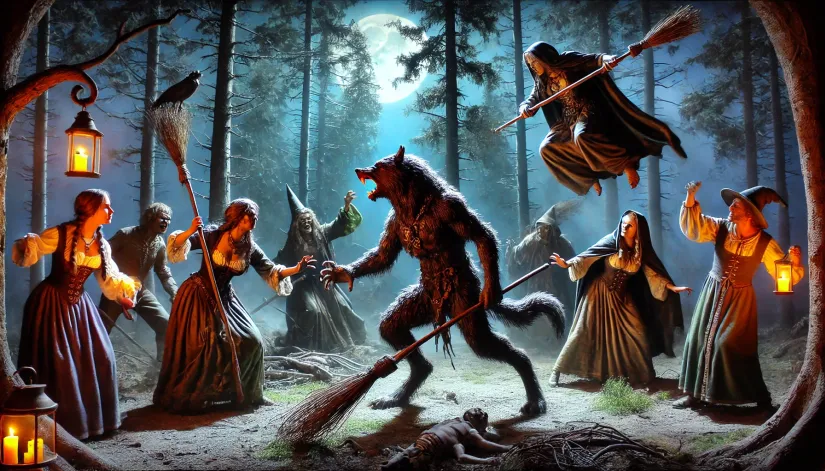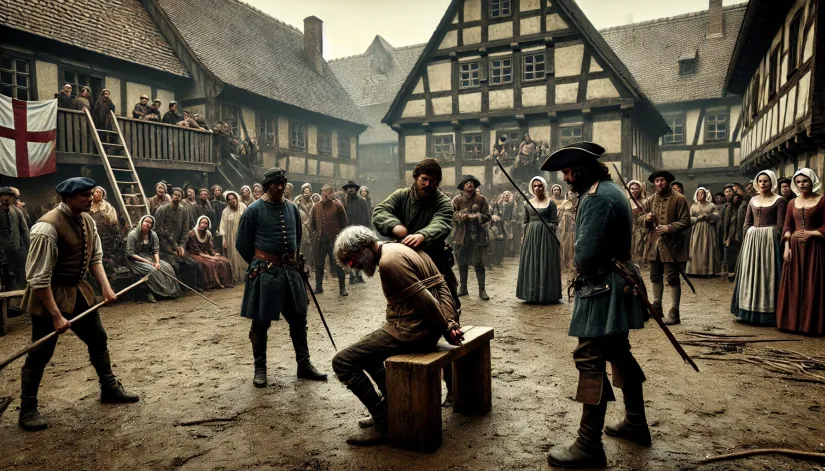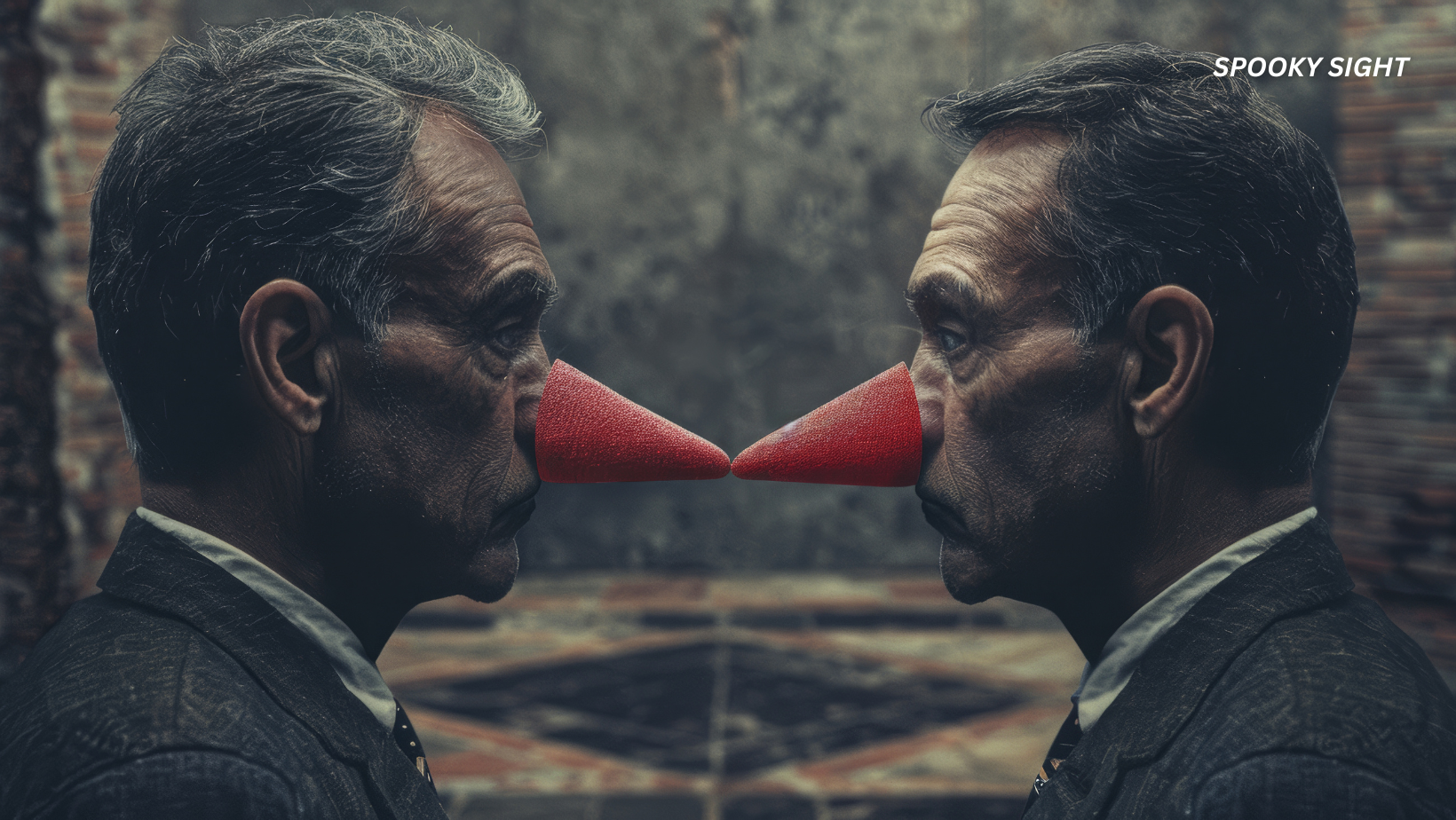In the tumultuous 17th century, Europe was gripped by a frenzy of werewolf and witch trials, driven by superstition and fear of the supernatural.
Among these trials, the peculiar case of Thiess of Kaltenbrun stands out as a fascinating anomaly.
Thiess, an octogenarian from Livonia (that’s modern-day Latvia and Estonia for you geography buffs), claimed he was no ordinary werewolf but a “Hound of God,” battling witches and demons to protect humanity.
His wild confessions and (the trial that followed) gives us a peek into a world where fairy tales and real life got mixed up with some hardcore religious persecution.
In this article:
Historical Background
The Early Modern period in Europe—roughly from the late 15th century to the 18th century—was a hot mess of fear and superstition. And no, that’s no exaggeration.
People all over Europe were getting dragged to court and executed for being witches or werewolves. All based on crazy accusations of witchcraft and lycanthropy. All fueled by religious, social, and political turmoil.
The Protestant Reformation (that kicked off in 1517 when Martin Luther nailed his “95 Theses” to a church door) turned the religious world upside down, increasing tensions and amplifying the focus on rooting out perceived heresy.

Witch Trials in Europe
Witch trials were all the rage, driven by religious zealots and people scared of their own shadows.
It all started ramping up in the late 1400s with the infamous “Malleus Maleficarum” (usually translated as the Hammer of Witches), published in 1487 by Heinrich Kramer and Jacob Sprenger. The book basically made the hunt for witches available to everyone, describing how to identify, interrogate, and execute witches.
It quickly became the go-to manual for witch hunters across Europe, selling over 30,000 copies by 1520.
Significant witch trials included:
- The Trier Witch Trials (1581-1593): One of the largest in Europe, resulting in the execution of over 300 people in present-day Germany. Notable victims included Dietrich Flade (a well-known judge and rector of the University of Trier), who was accused of witchcraft in 1588. His reputation and friends and family testimonials in his favor didn’t help. He was executed one year later, in 1589.
- The Würzburg and Bamberg Witch Trials (1626-1631): These were seriously messed up. Hundreds of people—including kids—got burned at the stake in Germany. In Würzburg alone, 157 people were killed between 1626 and 1631 (including 19 Catholic priests and several children as young as seven).
- The Pendle Witch Trials (1612): In Lancashire, England, these trials led to the execution of 10 people, largely based on the accusations of a single family. The trials centered around two families—the Devices and the Chattoxes—and were notable for the involvement of child witnesses.
- The Torsåker Witch Trials (1675): In just one day, in Torsåker, Sweden, on June 1, 1675, they killed 71 people, making it one of the deadliest witch hunts in Scandinavia. 65 of the victims were women.
- The Salem Witch Trials (1692-1693): You’ve probably heard of this one. Over in Massachusetts, they executed 20 people and locked up a bunch more. The events started in February 1692 with accusations by two young girls (Abigail Williams and Betty Parris) who pointed fingers at three local women.
Werewolf Trials
Werewolf trials weren’t as common, but they were just as nuts. People thought werewolves had made deals with the Devil to get their shape-shifting powers.
Here are some of the craziest cases:
- Philibert Montot, Pierre Bourgot, and Michel Verdun (1521, France): The case of Montot, Burgot, and Verdun is one of the earliest recorded werewolf trials. Verdun confessed, under torture, to transforming into a wolf and committing heinous crimes—including murder and cannibalism. He also implicated Bourgot and Montot in similar activities. Under torture, Bourgot admitted to striking a deal with three “demonic riders.” Montot, on the other hand, didn’t admit to anything. They were all executed by burning at the stake in Besançon on January 18, 1521.
- Gilles Garnier (1573, France): Better known as the “Werewolf of Dole,” Garnier confessed to killing and eating children while transforming into a wolf. He was arrested on January 14, 1573, and burned at the stake in Dole on January 18, 1574.
- The Beast of Gévaudan (1764-1767, France): While not a trial per se, the Beast of Gévaudan is still one of the most famous werewolf cases in history. What happened? A series of horrifying attacks on villagers in south-central France were attributed to a werewolf. This event led to widespread panic and numerous hunts to capture or kill the beast. Today, historians believe that these well-documented attacks (which killed over 100 people) were likely perpetrated by a pack of wolves or a hybrid species.
- Peter Stumpp (1589, Germany): Known as the “Werewolf of Bedburg,” this man’s case was off the charts. Stumpp confessed (again, after some serious torture) to making a deal with the Devil for a magic belt that turned him into a wolf. He claimed he’d been terrorizing the countryside for 25 years, killing and eating livestock, 13 kids, and two pregnant women. His execution on October 31, 1589, was like a horror show—they broke him on the wheel, ripped off his flesh with hot pincers, chopped off his head, and then burned his body. They even executed his daughter and mistress for good measure.
- Jean Grenier (1603, France): This case is extra messed up because Jean Grenier was just a kid—around 13 or 14 years old. He claimed his parents gave him a wolf skin that could turn him into a werewolf. The teen confessed to attacking and eating several children in the area. But here’s the twist: instead of executing him, the court decided he was mentally ill. They locked him up in a monastery (or an asylum based on other records) for life, which was pretty progressive for the time. Seven years later, a government representative checked on him and found Grenier walking on all fours and refusing to eat anything but raw meat.
The Unusual Case of Thiess of Kaltenbrun
Time to get back to our strange case here. So, who was Thiess of Kaltenbrun, and why is he one of the most famous werewolves in history?
In 1691, the small village of Jürgensburg in Swedish Livonia (present-day Zaube, Latvia) became the stage for one of the most unusual trials in history.
Thiess of Kaltenbrun, an 80-year-old man, found himself at the center of a legal spectacle at the provincial court in Venden (modern-day Cēsis, Latvia).
Initially called to testify in a church theft case on October 28, 1691, Thiess’s name was mentioned not as a suspect but as a known figure with peculiar practices and beliefs.

Thiess’s Testimony and Stories
During the trial, Thiess just straight-up admitted to being a werewolf. In fact, he claimed he’d been a werewolf for over 20 years, turning into a wolf by putting on a wolf skin.
He also claimed that he and his fellow “Hounds of God” would head down to Hell (through a special spot in the forest he called “the end of the sea”) to battle witches and demons.
Next, Thiess spun all sorts of crazy tales about night trips to Hell on holidays like St. John’s Eve (June 23), Christmas Eve, and Pentecost.
He even offered in-depth descriptions of these epic battles, in which werewolves used iron whips and witches fought back with broomsticks decked out with horsetails. But Thiess insisted they were doing God’s work.

In one particularly dramatic account, Thiess described a battle on St. Lucia’s Day (December 13) in 1690.
He claimed that he and his werewolf companions fought against a group of witches led by a man named Skeistan. The battle was fierce, with the werewolves eventually emerging victorious. Thiess even bragged that they’d “bitten noses and fingers” off the witches and stolen their booze and grain.
Thiess also talked about the perks of being a werewolf warrior.
He claimed that after they beat the witches, they’d come back with loads of grain and seeds. This, he argued, was proof of their divine mission from God to keep the crops growing and everyone fed.
But perhaps most shockingly to the court, Thiess of Kaltenbrun insisted that werewolves were Christians and that their souls went to Heaven when they died.
As for the lycanthropy curse? Well, it wasn’t really a curse at all. And it wasn’t permanent. Thiess claimed that werewolves could be released from their “duty” by a strike from a man with a scourge wrapped in goat leather, blessed on three consecutive Thursdays.

Thiess of Kaltenbrun Wasn’t Just a Self-Proclaimed Werewolf.
It turns out he was also the local medicine man—a respected folk healer who used charms and blessings to heal people and keep their animals safe.
For example, Thiess used blessed salt in warm beer for healing and invoked the power of the sun and moon (notably omitting God), which became a point of contention during his trial.
One of Thiess’s most popular services was the blessing of cattle to protect them from wolves. He would walk around the herd three times, reciting incantations that he claimed would make the animals invisible to predators.
He also had tricks for various human ailments, like a wart cure that involved rubbing a piece of meat on it and burying it under the house.
Over a decade, he served local Livonian peasants well, earning a reputation for his effectiveness and gaining a status akin to a folk saint. His services were typically compensated through small payments or bartering—often receiving food items like bread, cheese, or ale.
In fact, many in the community vouched for his sanity and contributions during his trial, with some testifying that his treatments had saved their livestock or cured their illnesses.
And all those testimonies were what probably saved his life.

Court’s Response and Punishment
Despite the captivating nature of his tales (and all the testimonies in his favor), the court still needed to uphold the religious and legal norms of the time.
Thiess’s lack of adherence to the Christian faith became a focal point.
He admitted to not attending church or partaking in sacraments for over 30 years, which (combined with his folk healing practices) painted him as a heretic in the eyes of the authorities.
Plus, the judges, led by Georg Thiringk, were particularly troubled by Thiess’s insistence that werewolves were servants of God rather than the Devil.
This claim contradicted the established belief that all supernatural transformations were the work of Satan. The court also took issue with Thiess’s use of pagan symbolism in his healing practices, viewing it as a form of idolatry.
On October 31, 1692, after a year-long trial, they found Thiess guilty of heresy and being a werewolf.
His punishment? A public whipping—20 lashes. The flogging took place in the town square of Venden, witnessed by a large crowd of locals and officials.
After the beating, they kicked Thiess out of the Grand Duchy of Lithuania. Given how old he was and how rough life was back then, this was pretty much a death sentence.
We don’t know precisely when or how he died, but let’s face it, it’s unlikely that he survived long after his banishment.
But despite all these, Thiess of Kaltenbrun got away with an extremely easy punishment. At least compared to the standard sentence for other “werewolves” and “witches.”

Closing Words
The case of Thiess of Kaltenbrun remains a unique and fascinating example of the complex interplay between folk beliefs, Christianity, and the legal system in Early Modern Europe.
His strange story stands out among werewolf trials, challenging typical facts about werewolves.
Why? Because unlike famous werewolves in literature (like Lawrence Talbot) or famous werewolves in mythology (such as King Lycaon), Thiess claimed to be a protector, not a monster.
His unique werewolf name, “Hound of God,” reflects this departure from traditional lore. Oh, and let’s not forget that while most werewolf accusations ended in execution, Thiess’s case resulted in flogging and exile.
Frequently Asked Questions
Who was Thiess of Kaltenbrun?
Thiess of Kaltenbrun was an 80-year-old Livonian peasant who lived in the late 17th century. He gained notoriety for his unusual claims during a trial in 1691. Thiess openly admitted to being a werewolf but insisted he was a benevolent one, fighting against witches and demons. He was also known in his community as a folk healer and protector of livestock.
What are the Hounds of God?
The “Hounds of God” was the term Thiess used to describe himself and his fellow werewolves. According to Thiess, these werewolves were not evil creatures but rather servants of God who fought against witches and demons to protect crops and ensure good harvests. This concept challenged the typical European belief that werewolves were servants of the Devil.
Was Thiess of Kaltenbrun a real werewolf?
There’s no evidence that Thiess of Kaltenbrun was actually a werewolf in the physical sense. His claims were likely a mixture of folk beliefs, pagan traditions, and possibly mental illness or dementia due to his advanced age. What’s significant is how his beliefs differed from the standard werewolf mythology of the time.
Why was Thiess of Kaltenbrun put on trial?
Thiess wasn’t initially put on trial for being a werewolf. He was called to testify in a church theft case in October 1691. During this testimony, he voluntarily admitted to being a werewolf, which led to a separate trial for heresy and lycanthropy.
The court was particularly concerned with his lack of Christian practice, his pagan-influenced healing methods, and his claims about being a divine werewolf, which contradicted established religious beliefs of the time.







